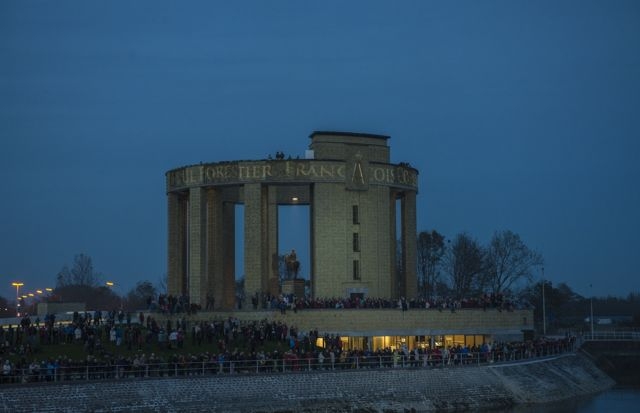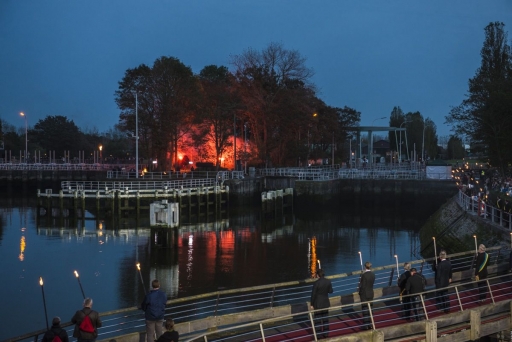Centenary News reports from ‘Light Front’, the torchlight event in Western Flanders on October 17th 2014, remembering the First World War battles which engulfed the region 100 years ago.
More than 8,000 torchbearers lined a route stretching 84 kilometres (more than 50 miles) from Nieuwpoort on Belgium’s North Sea Coast to the Memorial to the Missing at Ploegsteert, near the French border, where the Belgian Royal Family took part in a candle-lit ceremony.
The chain of light marked the line of the Western Front as it stood in late October 1914, after Belgian troops flooded the coastal plains during the Battle of the Yser to halt the German advance towards the French Channel ports.
Centenary News writer, Dr Jillian Davidson, watched the start of ‘Light Front’ in Nieuwpoort and sent us this first report from the scene:
‘At 6:50 pm, torches were lit alongside the Light Front at the foot of the King Albert Monument in Nieuwpoort. On the series of locks, known as the Goose Foot complex, people from Nieuwpoort lined up either as torchbearers or as onlookers. World War One affected practically every family in Nieuwpoort.
‘The Goose Foot lock complex witnessed the most significant tactical Belgian manoeuvre at the beginning of World War One. On the night of October 29th to 30th 1914, Belgian Royal Engineers opened the Veurne-Ambacht outlet locks.
‘Every night for eight days, they opened the locks and then closed them in the morning. The polders between the banks of the Yser and the Nieuwpoort-Diksmuide railway line became an impassable stretch of water. “This is why the Germans were stopped,” Minister-President of Flanders, Geert Bourgeois, explained at a press conference before the Light Front ceremony.’

The names of 600,000 people who died on Belgian soil in the First World War were projected onto the King Albert Monument in Nieuwpoort for ‘Light Front’. A new visitor centre, built for the Centenary, tells the story of the flooding (Image:© Sivan Askayo)
The westernmost part of Flanders was the only area of Belgium to remain unoccupied. King Albert I remained here at the head of his troops, allowing his 14-year-old son, Prince Leopold, to enlist in the Belgian army as a private and fight in its ranks.
The Belgian action on the Yser, together with the Allied defence of nearby Ypres, closed the last gaps in the Western Front. With no breakthrough by either the German or Allied armies, the front was now deadlocked from the North Sea to the Swiss border.
Light Front ’14 was organised as part of Gone West, the artistic commemoration of the Great War in the Province of West Flanders. Click on this video to watch highlights.
Images courtesy of Sivan Askayo/Visit Flanders
Posted by Peter Alhadeff, with Dr Jillian Davidson reporting for Centenary News from Nieuwpoort. A full report from Dr Davidson will follow later.
Sources: Province of West Flanders/Gone West/Visit Flanders/Wikipedia
